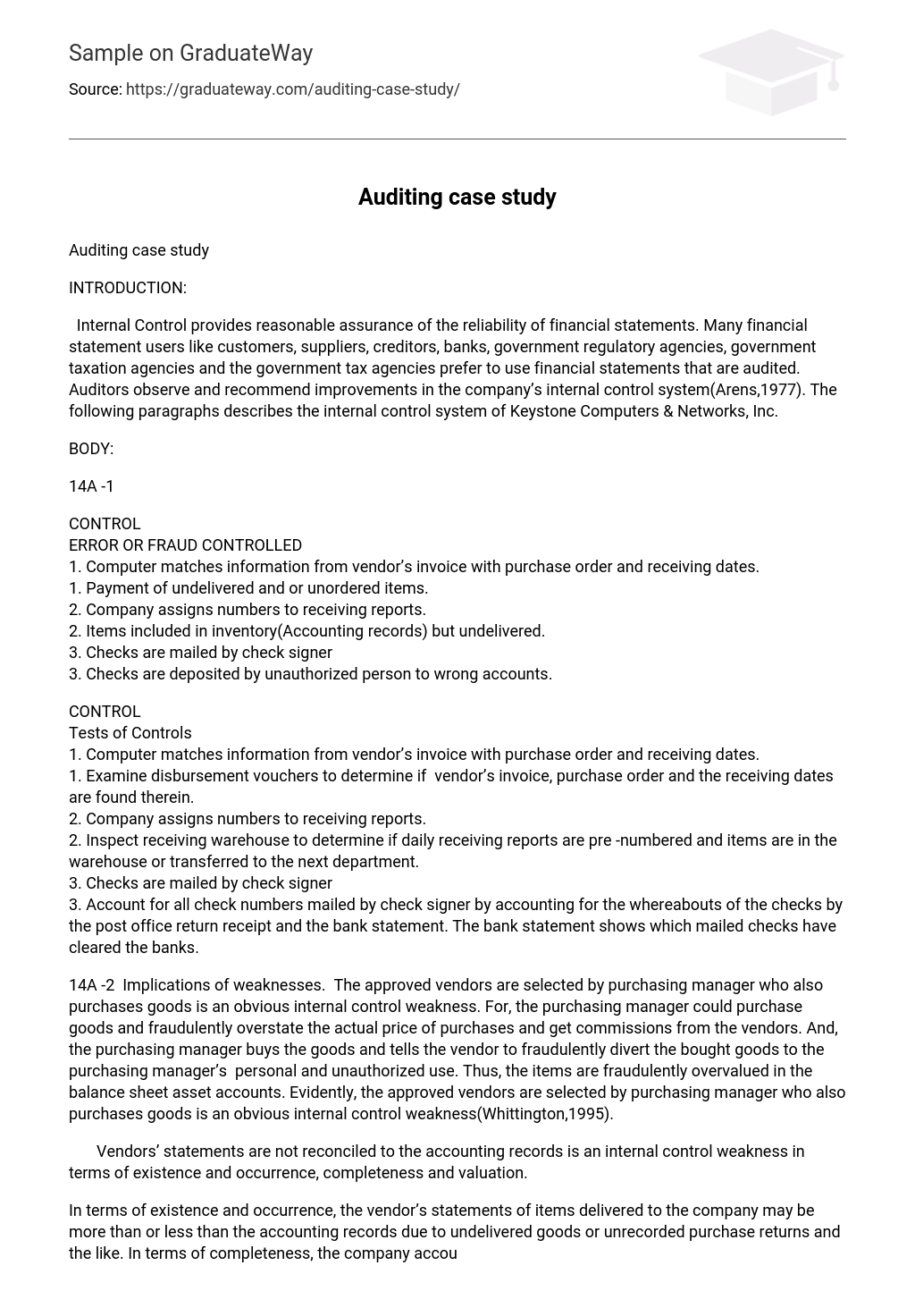INTRODUCTION:
Internal Control provides reasonable assurance of the reliability of financial statements. Many financial statement users like customers, suppliers, creditors, banks, government regulatory agencies, government taxation agencies and the government tax agencies prefer to use financial statements that are audited. Auditors observe and recommend improvements in the company’s internal control system(Arens,1977). The following paragraphs describes the internal control system of Keystone Computers & Networks, Inc.
BODY:
14A -1
CONTROL
ERROR OR FRAUD CONTROLLED
1. Computer matches information from vendor’s invoice with purchase order and receiving dates.
1. Payment of undelivered and or unordered items.
2. Company assigns numbers to receiving reports.
2. Items included in inventory(Accounting records) but undelivered.
3. Checks are mailed by check signer
3. Checks are deposited by unauthorized person to wrong accounts.
CONTROL
Tests of Controls
1. Computer matches information from vendor’s invoice with purchase order and receiving dates.
1. Examine disbursement vouchers to determine if vendor’s invoice, purchase order and the receiving dates are found therein.
2. Company assigns numbers to receiving reports.
2. Inspect receiving warehouse to determine if daily receiving reports are pre -numbered and items are in the warehouse or transferred to the next department.
3. Checks are mailed by check signer
3. Account for all check numbers mailed by check signer by accounting for the whereabouts of the checks by the post office return receipt and the bank statement. The bank statement shows which mailed checks have cleared the banks.
14A -2 Implications of weaknesses. The approved vendors are selected by purchasing manager who also purchases goods is an obvious internal control weakness. For, the purchasing manager could purchase goods and fraudulently overstate the actual price of purchases and get commissions from the vendors. And, the purchasing manager buys the goods and tells the vendor to fraudulently divert the bought goods to the purchasing manager’s personal and unauthorized use. Thus, the items are fraudulently overvalued in the balance sheet asset accounts. Evidently, the approved vendors are selected by purchasing manager who also purchases goods is an obvious internal control weakness(Whittington,1995).
Vendors’ statements are not reconciled to the accounting records is an internal control weakness in terms of existence and occurrence, completeness and valuation.
In terms of existence and occurrence, the vendor’s statements of items delivered to the company may be more than or less than the accounting records due to undelivered goods or unrecorded purchase returns and the like. In terms of completeness, the company accounting may not be updated in recording the goods that have passed through the receiving department and those that have been returned to the suppliers. In terms of rights and obligations, the accounting department could may not have recorded deliveries to the receiving department as evidenced by the suppliers’ statements which show the date of item receiving. Thus, liability and right to items have not been recorded in the accounting books. Glaringly, the vendors’ statements that are not reconciled to the accounting records is an internal control weakness in terms of existence and occurrence, completeness and valuation because of the lack of timeliness in recording assets delivered to the receiving department(Hall,2000).
14A -3. There should different persons assigned to purchasing, receiving and recording functions. Thus, the external auditor shall obtain an understanding of the internal control structure. The auditor gives the receiving department, warehouse, accounting department and purchasing department a set of internal control questionnaires. The auditor makes a flowchart showing the start to the finish of each flow of goods for the purchase requisition to the actual purchase order made, to the delivery of goods to the receiving department, to the delivery to the productions department until they are actually sold and converted to cash. The auditor will inspect if normal internal control where there should be separation of functions among people in the purchasing, receiving, processing, shipping and shipping to customers or stores functions is implemented.
Furthermore, the auditor should personally observe that the initiating of inventory purchases, other assets and services; placing purchase orders, inspecting goods upon receipts, and preparing receiving reports; recording liabilities to vendors, authorizing payment, and making and recording of cash disbursements are strictly implemented.
The audit procedures to test the effectiveness of internal control here includes inquiries of appropriate client personnel, inspection of documents and reports, observation of application of accounting policies or procedures and reperformance policy or procedure. For, tests of internal controls focuses on the performance of policies and procedures and not the accuracy of financial statement accounts.
CONCLUSION:
Internal control is a necessary internal company policy. Internal control provides reasonable assurance that financial statements are fairly presented. For, auditing includes implementation of strong internal control polices. Internal control decreases and even eliminates fraud and or errors in financial statements.
REFERENCES:
Arens A., Loebbecke J., Auditing an Integrated Approach, Prentice Hall, N.J., 1997
Whittington R., Pany K., Principles of Auditing, Irwin, Chicago, 1995
Hall, J., Information Systems Auditing and Assurance, South Western College Publishing, N.Y., 2000





